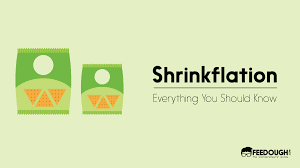Inflation hurts customers’ ability to pay for goods and they start to defer the purchase of goods. This is turn hurts the seller of goods as there is a reduction in the demand for goods. To counter this, sellers must work on innovative practices to sustain demand. Shrinkflation is one such.
Shrinkflation is the practice of reducing the size of a product while keeping its sticker price. Raising the price per given amount is a strategy employed by companies, in the food and beverage industries, to stealthily boost profit margins or keep them in the face of rising input costs.
Shrinkflation is also referred to as package downsizing in business and academic research. A less common usage of this term may refer to a macroeconomic situation where the economy is contracting while also experiencing a rising price level.
Understanding Shrinkflation
Shrinkflation is a term made up of two separate words: shrink and inflation. The “shrink” in shrinkflation relates to the change in product size, while the “Inflation” part refers to inflation—the rise in the price level.
Shrinkflation is a form of hidden inflation. Companies are aware that customers will spot product price increases and so opt to reduce their size of them instead, mindful that minimal shrinkage will go unnoticed. More money is squeezed out not by lifting prices but by charging the same amount for a package having a little bit less.
Academic research has shown that consumers are more sensitive to explicit price increases than to package downsizing, but that this practice can result in negative consumer brand beliefs and intentions to repurchase the product, and to static or declining unit sales volume over time.
The effectiveness of shrinkflation as a pricing strategy appears to vary across diverse types of goods and markets.
Most consumers do not check the size of a product. Someone who loves potato chips, for instance, may not realize if their favorite brand reduces the size of the bag by 5%, yet will certainly be able to tell if the price goes up by the same amount.
From a company perspective, shrinkflation is a useful way to boost or support profit margins without drawing too much attention. This tactic is most executed in the situations below.
Production Costs
Retailers often engage in shrinkflation to combat higher production costs. When key inputs, such as raw materials or labor, shoot up in valuation, the cost to manufacture final goods rises. This later weighs on profit margins; the percentage of revenue being still after all costs.
Management can either sit back and hope investors do not become too despondent or look to find other ways to recoup some of these losses. For companies lacking strong pricing power reducing the weight, volume, or quantity of products sometimes stands for the best option to keep a healthy profit without jeopardizing sales volumes.
Market Competition
Companies might also resort to shrinkflation to maintain market share. In a competitive industry, lifting prices could lead customers to jump ship to another brand. Introducing small reductions in the size of their goods, on the other hand, should enable them to boost profitability while keeping their prices competitive.
Drawbacks of Shrinkflation
Of course, shrinkflation tactics can also backfire badly. Most people will not notice slight changes to the size of a product. If they do, it could have a detrimental effect on consumer sentiment toward the perpetrator, leading to a loss of trust and confidence.
That means companies can only make these types of changes so many times before consumers will cry foul. They also need to be subtle and careful not to reduce sizes too much.
Another downside of shrinkflation is that it makes it harder to accurately measure price changes or inflation. The price point becomes misleading since the product size cannot always be considered in terms of measuring the basket of goods.
Notice and Avoid Shrinkflation
One of the best ways to notice shrinkflation is by spotting a redesign on the packaging or a new slogan. This may signal the company has made a change and that change may be the size.
Shoppers can look at the price per unit to see if there has been a change; however, it may be difficult to remember the prior price per unit, but comparing the price per unit to assorted products can help you get the best deal.
Companies often change the design of the product container so that shrinkflation is not visibly noticeable. The only way to be completely sure is by checking the numbers on the packaging.
One way to avoid shrinkflation is by buying competing brands. Competing brands may not have downsized yet and so you may get more value for the price you pay. Another method is opting for the store brand rather than a name brand. Store brands in general are cheaper than name brands.
Lastly, learning the net weights of products and what you are paying for them can help you notice any changes and which products are going to be the better value.
Special Considerations
The U.K. government regularly tracks shrinkflation. According to its Office for National Statistics (ONS), between the beginning of 2012 and June 2017 (latest information), 2,529 products decreased in size, while only 614 became bigger.
Interestingly, shrinkflation’s effects on price changes were not visible, even within the food and non-alcoholic beverages category, though the ONS did calculate that the phenomenon boosted inflation in the sugar, jam, syrups, chocolate, and confectionery category by 1.2 percentage points from the beginning of 2012 to June 2017, as per the chart below.
Real-World Examples
- Haldiram has cut down the size of its Aloo Bhujia packet to 42 gm from 55 gm.
- Nestle has reduced the quantity of Maggi from 80 gm to 55 gm.
- Tetley Green Tea has reduced the quantity of tea bags in one box from 100 to 88.
Reasons for Shrinkflation
The primary reason for shrinkflation is the increase in production costs. If the cost of the raw materials needed to create a product increases, the company can pass those increased costs onto the customer by either increasing the price or keeping the price the same but reducing the size of the product; the latter being shrinkflation. Production costs would include the commodity needed to make the product, fuel to run machinery, electricity to run the plant, and labor costs.

(This article is written by Vinishadevi SM, Audit Executive at R V K S And Associates)
